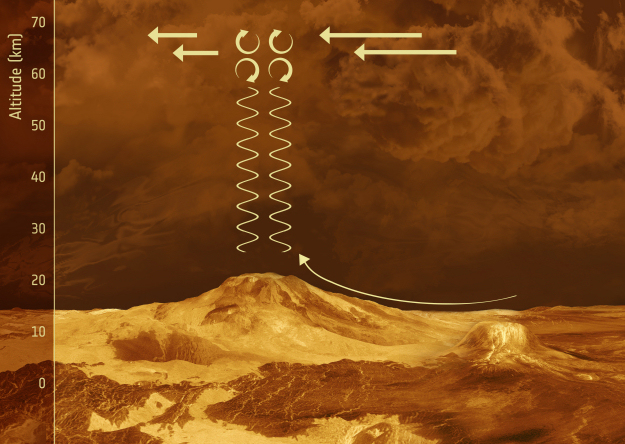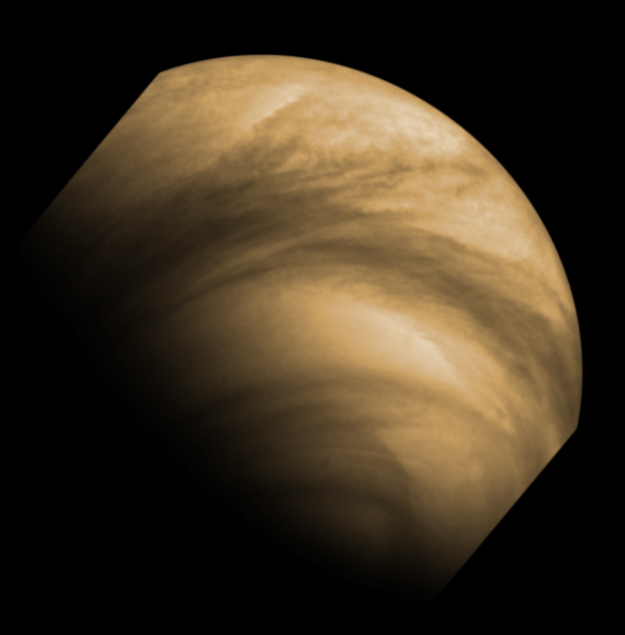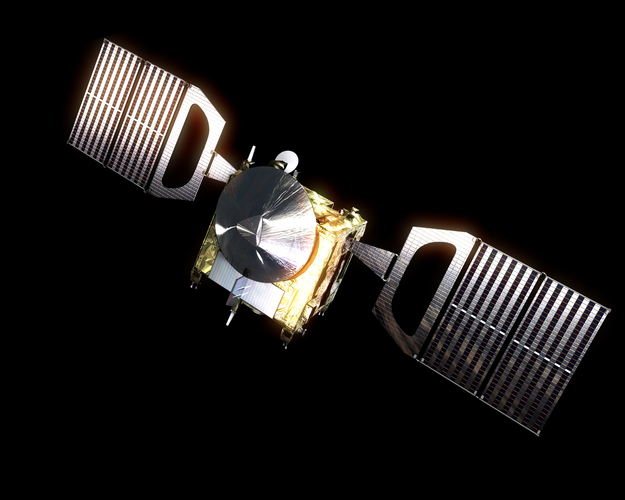Venus weather patterns reveal planet’s surface
New research, based on data from ESA's Venus Express satellite, for the first time reveals how the weather patterns on Venus are directly connected to the surface topography of the planet. Results suggest the Venus' thick cloud cover could offer further information about the processes unraveling beneath, instead of acting as a barrier to limit observations of the planet.
An extremely pronounced greenhouse effect can heat the Venus up to 450 °C (842 °F). In addition to being hot, the planet's surface is dimly lit because of a thick cloud layer. Surface winds as also very slow, not exceeding the speeds of 1 m/s (3.3 feet/s).
An observed smooth and bright, 20 km (12.4 miles) thick cloud cover is situated between 50 and 70 km (31 and 43.5 miles) above the surface. Temperatures are similar to those recorded at the cloud tops of Earth, about -70 °C (-94 °F). Upper cloud layers are known for extreme weather conditions, with winds hundreds of times faster than surface ones, and faster than the planet's own rotation, the so-called super-rotation phenomenon.
So far, the thick cloud layer has blocked the scientists from observing the surface. However, researchers have suspected the weather patterns may be influenced by the underlying planet's topography, and have managed to provide a complete picture of such an occurrence for the first time, using observations from ESA's Venus Express. The satellite is capable of providing information on the speed of wind circulation, the amount of water stored within clouds, and the clouds' brightness across the spectrum, specifically in its ultraviolet part.

Schematic illustration of the proposed behavior of gravity waves in the vicinity of mountainous terrain on Venus. Winds pushing their way slowly across the mountainous slopes on the surface generate gravity waves – an atmospheric phenomenon also often seen in mountainous parts of Earth's surface. These waves form when air ripples over bumpy surfaces. The waves then propagate vertically upwards, growing larger and larger in amplitude until they break just below the cloud-top, like sea waves on a shoreline. As the waves break, they push back against the fast-moving high-altitude winds and slow them down. The background is an artist's impression of the surface of Venus beneath the cloud tops. Image credit: ESA
"Our results showed that all of these aspects – the winds, the water content, and the cloud composition – are somehow connected to the properties of Venus' surface itself. We used observations from Venus Express spanning a period of six years, from 2006 to 2012, which allowed us to study the planet's longer-term weather patterns," said Jean-Loup Bertaux of Laboratoire Atmosphères, Milieux, Observations Spatiales (LATMOS), France, the lead author of the Venus Express study.
Venus' atmosphere contains some water, mainly beneath the cloud layer, in the form of vapor. The scientists have studied planet's cloud tops in the infrared light, which allowed them to observe the amount of it present at each location. One region of clouds, located near the Venus' equator, above a 4 500 m (14 764 feet) high mountain range of Aphrodite Terra, was found to contain more water vapor than the rest of the observed surroundings. According to the scientists, the phenomenon dubbed 'the fountain of Aphrodite' was likely caused by the air rich in water from the lower part of the atmosphere, forced above the mountains.

False-colour image of cloud features seen on Venus by the Venus Monitoring Camera (VMC) on Venus Express. The image was captured from a distance of 30 000 km (18 641 miles) on December 8, 2011. Image credit: ESA/MPS/DLR/IDA
"This 'fountain' was locked up within a swirl of clouds that were flowing downstream, moving from east to west across Venus. Our first question was, 'Why?' Why is all this water locked up in this one spot?," said co-author Wojciech Markiewicz of the Max-Planck Institute for Solar System Research in Göttingen, Germany.
The clouds were also imaged in the ultraviolet part of the spectrum to track the speeds of their movements. The clouds lying downstream from the fountain reflected lower amounts of ultraviolet light while the winds above the mountain region were about 18% slower than in the neighborhood. The scientists explained this by a mechanism, likely caused by the planet's thick atmosphere.
"When winds push their way slowly across the mountainous slopes on the surface they generate something known as gravity waves. Despite the name, these have nothing to do with gravitational waves, which are ripples in space-time – instead, gravity waves are an atmospheric phenomenon we often see in mountainous parts of Earth's surface. Crudely speaking, they form when air ripples over bumpy surfaces. The waves then propagate vertically upwards, growing larger and larger in amplitude until they break just below the cloud-top, like sea waves on a shoreline," explained Bertaux.
The waves break and then push back against the high-altitude winds that slow them down. After that, they re-accelerate again downstream of Aphrodite Terra, acting as an air pump. The air circulation creates an upward motion which carries the water-rich air and ultraviolet-dark material up to the surface of the cloud layer, creating the fountain and a downwind vapor plume.

Artist's impression of the Venus Express satellite, November 14, 2005. Image credit: ESA
"We've known for decades that Venus' atmosphere contains a mysterious ultraviolet absorber, but we still don't know its identity. This finding helps us understand a bit more about it and its behavior – for example, that it's produced beneath the cloud-tops, and that ultraviolet-dark material is forced upwards through Venus' cloud tops by wind circulation," said Bertaux.
Researchers suspected of the existing ascending motions along the planet's equator, caused by higher solar radiation. The discovery suggests the amount of water and the ultraviolet-dark material is especially enhanced along the particular areas around the Venus' equator, probably caused by the mountains on the planet's surface, triggering rising waves and circulating winds that dredge up the underlying material.
The discovery showed the Venus' surface topography significantly impacts atmospheric circulation, consequently affecting the planetary super-rotation, and general climate patterns.
"This certainly challenges our current General Circulation Models. While our models do acknowledge a connection between topography and climate, they don't usually produce persistent weather patterns connected to topographical surface features. This is the first time that this connection has been shown clearly on Venus – it's a major result," concluded Håkan Svedhem, ESA Project Scientist for Venus Express.
"This research wouldn't have been possible without Venus Express' reliable and long-term monitoring of the planet across multiple parts of the spectrum. The data used in this study were collected over many years. Crucially, knowing more about Venus' circulation patterns may help us to constrain the identity of the planet's mysterious ultraviolet absorber, so we can understand more about the planet's atmosphere and climate as a whole," said Svedhem.
Reference:
- "Influence of Venus topography on the zonal wind and UV albedo at cloud top level: The role of stationary gravity waves" – Jean-Loup Bertaux, I. V. Khatuntsev, A. Hauchecorne, W. J. Markiewicz, E. Marcq, S. Lebonnois, M. Patsaeva, A. Turin, A. Fedorova – Journal of Geophysical Research (2016) – DOI: 10.1002/2015JE004958
Featured image: A false-colour image of cloud features seen on Venus by the Venus Monitoring Camera (VMC) on Venus Express. The image was captured from a distance of 30 000 km (18 641 miles) on December 8, 2011. Image credit: ESA/MPS/DLR/IDA

Commenting rules and guidelines
We value the thoughts and opinions of our readers and welcome healthy discussions on our website. In order to maintain a respectful and positive community, we ask that all commenters follow these rules.